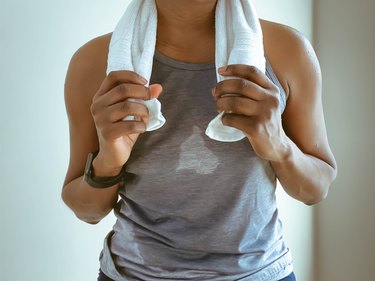
When you're taking steps to better your health, the last thing you want to be rewarded with is a heat rash after a workout. The good news is these rashes aren't generally serious, and there are simple ways you can soothe your skin before your next workout.
What Are Heat Rashes?
Video of the Day
Heat rashes generally come about, just as the name suggests, in the summer months due to the hot and humid weather. "They develop when your pores become clogged, and the sweat produced by your glands cannot get to the surface and evaporate," says Gretchen Frieling, MD, a Boston-area dermatopathologist. Heat rash symptoms can range from mild to extreme.
Video of the Day
According to Dr. Frieling, the mildest form of heat rash is marked by clear and fluid-filled blisters and bumps. Then, as the severity veers toward the most extreme form, you'll notice bumps that are red, inflamed and pus-filled.
Rashes tend to show up in places where people sweat the most, including the face, neck, under the breasts, the groin or between the thighs — anywhere that's exacerbated by friction. No matter the location, Johns Hopkins Medicine says, the rash may itch or cause an uncomfortable prickly sensation, depending on the severity.
"Heat rashes also occur in skin folds, such as in the armpits or behind your knee," Dr. Frieling says. "This happens because you're producing more sweat, but at the same time, it's harder for it to evaporate due to the skin folds. For that same reason, heat rashes also have a habit of forming under tight clothing, so the best way to avoid this is by wearing looser clothing."
Heat Rashes After Exercising
When you exercise, your body becomes hot and produces a lot of sweat. Sweating itself is healthy because it's how your body cools itself off during a workout, Dr. Frieling notes, but the problems begin when it's unable to evaporate.
"The sweat produced by your glands during the exercise typically evaporates into the air and takes body heat with it," she says. "However, heat rashes form when the high amounts of sweat being released during the workout clog your pores."
Heat rashes can also be seen as an indicator of a more serious problem. According to the Baylor College of Medicine, a heat rash can serve as a warning that you're setting your body up for something more severe, like heat exhaustion or heat stroke. It's a clear sign that your body is becoming overheated, and to prevent anything worse from happening, getting into a cool environment is a must.
Heat Rash Prevention and Treatment
To prevent heat rashes, Dr. Frieling recommends avoiding exercising in hot, humid temperatures.
If you're a runner, stick to exercising during cooler times of the day — not in the middle of the afternoon when the sun is blaring. If you do get a heat rash, don't worry — the first step in treating it is cooling your body temperature.
"This can be done by taking a cool bath or shower, applying ice packs or cold cloths, wearing loose-fitting clothing, applying cooling/soothing gels with aloe vera and lowering the air conditioner," she says.
Your heat rash should clear up on its own, rarely requiring any medical attention. However, if your symptoms last for more than a few days or the rash becomes painful, swells or shows any signs of infection — like pus draining from the bumps — the Mayo Clinic advises seeing your doctor. If it's severe, you may be prescribed a medication to help calm the inflammation and get your skin back to normal again, Baylor College of Medicine says.
Read more: Can Caffeine Make You Sweat Uncontrollably?
Is this an emergency? If you are experiencing serious medical symptoms, please see the National Library of Medicine’s list of signs you need emergency medical attention or call 911.